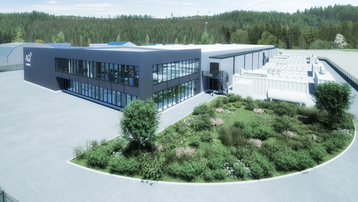There’s a crunch coming.
In Europe, it is becoming increasingly clear that the most popular data center markets are running up against power and land limitations. Frankfurt, London, Amsterdam, Paris, and Dublin (FLAPD) won’t be able to support all of the continent’s data center capacity.
Where will the overspill go?
Before we address that, it’s first important to reiterate that FLAPD will remain the top locations, for a while. For 2023 alone, CBRE predicted 480MW of take-up across the European hotspots and 524MW being developed. JLL also made record-breaking predictions in May 2023 (though smaller than those of CBRE), suggesting that 432MW of capacity will be developed across the key markets.
“There’s still an insatiable demand for these [FLAPD] locations,” said Ben Stirk, co-head of data center advisory at Knight Frank, during a DCD panel. “The cloud has generally gone to the most mature markets because they're either capitals, or financial hubs, or just big metros.”
Beyond these key locations, there are several adjacent or ‘secondary’ markets which are seeing significant growth. JLL’s latest EMEA data center report drew attention to the expected Madrid and Berlin sites, and throughout the panel, participants noted the value of Manchester in the UK, Warsaw in Poland, and Barcelona in Spain - though all of these have their own constraints.
This feature appeared in Issue 51 of the DCD Magazine. Subscribe for free today.
Data center demand is increasing across all verticals - retail and wholesale colocation, cloud, AI-dedicated data centers, and Edge facilities. While they are all data centers, their “needs” from a location vary wildly.
Ash Evans, Google’s EMEA lead of energy and location strategy, theorizes that we are at a point of major divergence, where data center sub-asset classes are becoming even more distinct.
“I think we're seeing the emergence of a new asset class in terms of AI and ML data centers in particular, which are on another scale again, and arguably have a different set of specifications. Are they less reliable? Do they even need to have the same reliability? Do they have the same latency requirement?” said Evans. “This is then where we have the divergence of two different machine learning style data centers.“
Evans compares the two categories of data center between the model training centers - which are “gigawatt plus scale,” and the inference data centers which are smaller, but still a “significant step up” from the cloud data centers of today. The former will likely be less latency-constrained, while the latter will still be bound by its strictures.
What impact this new asset class will have on FLAPD, is unclear.
As we all know, Edge is about the super low latency, close to the end-user model. As a result, these facilities do not necessarily conform to the FLAPD model in Europe anyway. The whole point is that they can be deployed as and where needed. But these are smaller sites - and in the big picture, don’t have the same paradigm-shifting effect.
Where things seem to be getting a little messy for Europe is in the hyperscale facilities: The cloud and AI data centers, both those used for training and for inference. The amount of power these data centers need is extortionate, as is the physical land space, which major cities simply do not have to spare.
“Trying to site renewables and data center capacity in a latency-sensitive location is always a challenge. They don’t go hand in hand, and when it comes to the major drivers such as cloud, artificial intelligence (AI), and machine learning (ML), we’re starting to get pushed away from those metropolitan areas,” said Evans.
Thus, instead of looking at high-connectivity FLAPD locations, data center developers in this realm need to evolve their approach to site selection. “I think we will start to see more and more concepts whereby large-scale renewable developments are sited or colocated next to hyperscale AI or machine learning data centers,” said Evans.
This is logical for a multitude of reasons: It keeps the technology green, and the impact off the local grid. It also does not need to be directly “close” to a population - training workloads can be done in isolation, and latency is not a key concern.
Land surrounding the FLAPD areas is also extremely expensive, and paying for a premium that isn’t actually necessary makes little to no sense.
From the real estate point of view, Stirk points out that the logical place in terms of resources is in the Nordics.
“[The Nordics] are the obvious place for these big training centers. They have cheap land, cheap renewable power, and free air cooling, all of which provide a great opportunity for these massive deployments,” said Stirk.
This is an argument that has been taken to heart by the likes of AQ Compute. DCD previously interviewed the company’s Norway CEO Andreas Myr, which has a business model where they develop AI and HPC data center sites in remote areas, the first of which will be pulling energy from Norway’s hydroelectric dams.
Similarly, atNorth is currently working on a 60MW hyperscale facility in Kouvala, Finland. In addition to the added benefits of free air cooling, the region has a developed heat market, and district heating systems provide an ideal opportunity for heat reuse. The company is also pitching a similar approach in Iceland.
Stirk, however, raises the issue that alongside the benefits of these locations, less mature markets pose a risk from their lack of workers. “It’s all very well having a data center in the Arctic Circle, but actually, who lives there?” he said.
“Looking at places like Dublin, one of the reasons that hyperscalers went there originally was because of the access to skills and talent in that area. There is a big tech pool that has grown, and it has a similar effect in places like London and Frankfurt.”
For the time being, developers and major contractors are bringing workers with them, and Arup’s George Demetriou, director of mission-critical business areas, said.
“They [major contractors] take their teams and settle them near the project, and then build the data centers. That’s a model we’ve seen in FLAPD, and we see that now happening elsewhere. Whether that is sustainable is to be seen but, for now, it is working,” he said. “With the amount of data centers required in these areas, one project can be finished and the same team can easily stay on and develop the next one.”
In the long term, these talent pools will need to expand. Those nomadic teams could work with local contractors, upskilling them and spreading the talent pool wider to new locations, but it is also the responsibility of the data center operators to make waves.
“While Google has a large ground-up talent pool development scheme, we can still do better at attracting talent and engaging earlier,” conceded Evans. “A great example of a sister industry that’s been successful at this is the oil and gas industry. They attract talent straight out of universities and colleges and provide very clear career paths and progressions. As of today, I certainly haven’t seen a lot of that [in the data center industry].”
While the AI boom of the end of 2022 has continued on through to 2023, Demetriou argues that Europe hasn’t really seen the true impact of it yet. “We haven’t seen it in our region as much yet,” said Demetriou. “We have heard a lot about ‘it's going to happen, it's going to come, it's going to be huge,’ and we’ve seen that in the US, and we believe it is going to follow in EMEA and then the Asia Pacific region.”
We can look to the US as both a ‘model’ of sorts of what is to come. Aashna Puri, director of business development and sustainability for CyrusOne, puts the significant size of deployments in the US down to the AI spring - noting that in the last quarter alone it has reached close to two gigawatts.
Puri’s question, however, is whether GDPR or data localization is going to mean that the learning and training of AI in the US has to be replicated in Europe also, or whether we can simply connect to that in the US, and then process in Europe.
With the AI era of data centers still in its infancy, it is very hard to draw definitive conclusions. Nations are still debating the regulations surrounding the technology and, while to outsiders it can feel like its progress is spinning wildly out of control, AI will be limited by the ability of the data center industry to figure out the best solution to these problems.
Many operators, for the time being, will retrofit their existing facilities or developments in order to accommodate AI workloads, instead of starting from the ground up - and that won’t necessarily spell the end for FLAPD. This seems to be the approach taken by Data4, which told DCD that it believes the scale of its existing campuses - a 180MW site in Frankfurt and two in Paris (120MW and 250MW) - will be ideal for accommodating the needs of AI.
Similarly, at the recent AI Safety Summit hosted at Bletchley Park in the UK, Microsoft committed to investing £2.5 billion ($3.16bn) in building artificial intelligence infrastructure in the UK. While details are sparse, some of this will go to its existing data centers in Cardiff and London, with “potential expansion into northern England.”
The future of the European data center market is likely to play out as it always has: with caution, but steady growth. If the AI data center takes over then, perhaps, we will all be meeting to discuss which letter will be added to FLAPD.






